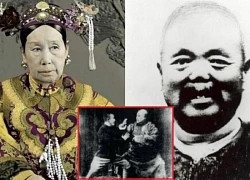Taeil: Idol kicked out of NCT by SM due to scandal, used to be very hot, even set a Guinness Record

2 | 1 Discuss | Share
People were surprised to see a long horn on the forehead of a woman over 100 years old. Locals call it the "longevity horn" and she herself believes that her longevity is due to it.
An old woman named Chen (living in Puning, Guangdong Province, China) suddenly became a local celebrity because of the strange horn growing on her forehead. This 10cm horn appeared a few years ago, and is called "longevity horn" by local people.
Mrs. Chen believes that her long life and good health are due to this horn. And the unusual facial features do not affect her daily life much. Mrs. Chen is still healthy, has a good appetite and a positive outlook.
Recently, Ms. Chen’s “longevity horn†has become more and more known after a video of her was posted on the social network Douyin . The online community was very surprised by its appearance. Many people even said that the old lady should not have removed it if it did not cause any effects:
"She can apply for Guinness World Record certification"; "I wish everyone lived that long"; "My grandmother had a tumor on her head. She went to the hospital to have it removed, but passed away two days after she returned"; "If it doesn't affect her life, she should leave it and monitor it regularly"...
Doctors diagnosed the horn on Ms. Chen’s forehead as a cutaneous keratomas, which are often associated with long-term exposure to sunlight. Although this type of keratomas is generally benign, experts still recommend monitoring because the risk of becoming malignant remains.
It is known that Ms. Chen is not the only elderly person in China who has "grown horns". In 2015, Ms. Liang Xiuzhen, 87 years old, living in Guiyan village (in Ziyang city, Sichuan province) also became famous, and was nicknamed "unicorn old lady" by many people because of a 13cm long "horn" growing on the top of her head.
Her son, Mr. Wang Chaojun, said that at first, something like a black mole appeared on Ms. Liang's forehead. Later, the mole grew into a small lump the size of a fingertip, without causing pain.
While washing his mother’s hair, Mr. Wang accidentally knocked the tumor off his mother’s head and over the next six months, a new tumor appeared and grew rapidly. From being only as small as a fingertip, Ms. Liang’s tumor grew to 13cm long and looked like a horn.
The doctor diagnosed Ms. Wang with a rare skin condition called keratoderma with a keratoderma-like tumor. This type of tumor usually appears small but gradually grows larger and can become malignant. They advised her to have surgery to remove the tumor.
In the history of medicine, there have been many cases of people growing extremely strange horns, similar to Ms. Chen and Ms. Liang. These horns look very hard, but in fact they are made of keratin, just like hair or nails, so scientists call them cutaneous horns.
Normally, these skin horns will grow from the head or ears of mammals that do not have horns. However, according to research, skin horns are especially common in humans than animals.
Keratosis pilaris is a type of skin tumor that occurs when excessive keratin builds up and then forms a horn that protrudes from the skin. Unlike other tumors, keratomas have a very distinctive shape, resembling the horns of animals, hence the name of this disease.
The oldest recorded case of horns was Mary Davis, who lived in Saughall, Cheshire, England in the 17th century and had four horns. One of Mary's horns is now on display at the Museum of Jurassic Technology in Culver City, California, USA.
Another case of the longest horn was a woman in Paris in the 19th century, Madame Dimanche. According to records, the horn began to appear in the middle of Mrs. Dimanche's head when she was 76 years old and continued to grow longer after that.
Initially, doctors said the horn was not a dangerous condition and refused to remove it. However, over time, the horn continued to grow, affecting the patient's life. Finally, she had the horn removed, by which time it had grown to over 25cm long and was hanging right in front of her face. Today, a wax model of Dimanche is on display at the Mutter Museum in Philadelphia.
It is worth noting that scientists still do not understand why keratosis pilaris occurs. However, horns usually grow in areas of the skin that are exposed to a lot of light, such as the face, neck, ears, back of the hands, top of the head, etc. Therefore, many hypotheses suggest that solar radiation may be what stimulates the disease to develop.
It has also been speculated that the human papillomavirus (HPV) may also be involved, as a form of the virus in humans causes thick, bark-like growths on the hands and feet, similar to keratoderma.
About 20% of cutaneous horns can be a sign of a potentially dangerous skin disease such as carcinoma. In most cases, these horns are not a cause for concern except that they are unsightly. Patients with cutaneous horns can have them removed with a fairly simple surgery.
Although many hypotheses have been put forward by scientists, until now, they still cannot have an exact explanation for the strange phenomenon of horn growth in humans.
Girl's face burned while saving her boyfriend's mother, loved and pampered, the truth is far different  An Nhi07:12:46 10/10/2024The special love story of a girl with a face disfigured by burns and her handsome lover has been attracting the attention of the online community recently. From here, many stories behind this love story have been discovered and discussed enthusiastically.
An Nhi07:12:46 10/10/2024The special love story of a girl with a face disfigured by burns and her handsome lover has been attracting the attention of the online community recently. From here, many stories behind this love story have been discovered and discussed enthusiastically.

2 | 1 Discuss | Share

1 | 1 Discuss | Share

1 | 1 Discuss | Share

1 | 1 Discuss | Share

3 | 1 Discuss | Share

1 | 1 Discuss | Share

1 | 1 Discuss | Share

2 | 1 Discuss | Share

3 | 1 Discuss | Share

3 | 0 Discuss | Share

2 | 0 Discuss | Share

5 | 0 Discuss | Share



4 | 1 Discuss | Report